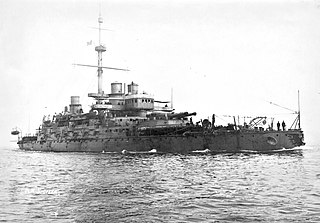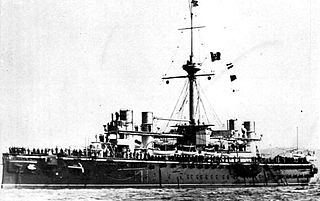Italia may refer to the following:

An ironclad is a steam-propelled warship protected by iron or steel armor plates, constructed from 1859 to the early 1890s. The ironclad was developed as a result of the vulnerability of wooden warships to explosive or incendiary shells. The first ironclad battleship, Gloire, was launched by the French Navy in November 1859 - narrowly pre-empting the British Royal Navy. After the first clashes of ironclads took place in 1862 during the American Civil War, it became clear that the ironclad had replaced the unarmored ship of the line as the most powerful warship afloat. This type of ship came to be very successful in the American Civil War.
Roma was the name of three ships of the Regia Marina, and may refer to:
Ruggiero di Lauria may refer to:

Re Umberto was a Re Umberto-class ironclad battleship built for the Italian Regia Marina in the 1880s, the lead ship of her class. She was laid down in July 1884 and launched in October 1888; work proceeded so slowly that she was not finished until February 1893. She was armed with a main battery of four 13.5-inch (340 mm) guns and had a top speed of 20.3 knots, though this high speed came at the cost of armor protection.

Sicilia was the second of three Re Umberto-class ironclad battleships built for the Italian Regia Marina. The ship, named for the island of Sicily, was laid down in Venice in November 1884, launched in July 1891, and completed in May 1895. She was armed with a main battery of four 13.5-inch (340 mm) guns and had a top speed of 20.3 knots, though this high speed came at the cost of armor protection.

Italia was an Italian ironclad battleship built for the Italian Regia Marina, the lead ship of the Italia class. She and her single sister ship, Lepanto, had lengthy construction times. Italia was laid down in January 1876, launched in September 1880, and completed in October 1885. She was armed with a main battery of four 17 in (432 mm) guns mounted in a central barbette and was capable of a top speed of 17.8 knots. Unusually, for ships of that era, Italia had an armored deck rather than the typical belt armor.

Lepanto was an Italian ironclad battleship built for the Italian Regia Marina, the second and last ship of the Italia class. Lepanto was laid down in November 1876, launched in March 1883, and completed in August 1887. She was armed with a main battery of four 17 in (432 mm) guns mounted in a central barbette and was capable of a top speed of 17.8 knots. Unlike other capital ships of the era, Lepanto had an armored deck rather than the more typical belt armor.

The Ruggiero di Lauria class was a class of ironclad battleships built for the Italian Regia Marina during the late 19th century. The three ships—Ruggiero di Lauria, Francesco Morosini, and Andrea Doria–were improved versions of the earlier Duilio-class ironclads. The primary improvements were new breech-loading guns, better armor protection, and more powerful machinery. The ships, designed by Giuseppe Micheli, marked a temporary diversion from the ideas of Benedetto Brin, who had designed the two preceding classes along with the following class.

Ruggiero di Lauria was an ironclad battleship built in the 1880s for the Italian Regia Marina. She was the lead ship of the Ruggiero di Lauria class, which included two other ships, Francesco Morosini and Andrea Doria. Ruggiero di Lauria, named for the medieval Sicilian admiral Ruggiero di Lauria, was armed with a main battery of four 17-inch (432 mm) guns, was protected with 17.75-inch (451 mm) thick belt armor, and was capable of a top speed of 17 knots.

Andrea Doria was an ironclad battleship built for the Italian Regia Marina in the 1880s and 1890s. Named for the 16th-century Genoese admiral Andrea Doria, she was the third and final ship of the Ruggiero di Lauria class. The ship was armed with a main battery of four 17-inch (432 mm) guns, was protected with 17.75-inch (451 mm) thick belt armor, and was capable of a top speed of 17 knots.
Four ships of the Regia Marina, and the present day Italian Navy, have borne the name Duilio or Caio Duilio, the name commemorating the 3rd century BC Roman naval leader Gaius Duilius:
Andrea Doria has been borne by five ships of the Italian military and merchant navy, after Andrea Doria and may refer to:

SMS Kaiser was a 92-gun wooden ship of the line of the Austrian Navy, the last vessel of the type, and the only screw-driven example, to be built by the Austrians. She was built by the naval shipyard in Pola; she was laid down in March 1855, was launched in October 1858, and was completed the following year. The ship took part in the Second Schleswig War of 1864, but saw no action during her deployment to the North Sea. Kaiser did see action during the Seven Weeks' War two years later, during which she took part in the Battle of Lissa as the flagship of Anton von Petz, commander of the Austrian 2nd Division. Kaiser engaged several Italian ironclads simultaneously, rammed one—Re di Portogallo—and damaged another—Affondatore—with gunfire. In doing so, she became the only wooden ship of the line to engage an ironclad warship in battle.
Three ships of the Austrian and later Austro-Hungarian Navy have been named SMS Prinz Eugen in honor of Prince Eugene of Savoy
Francesco Morosini or simply Morosini has been the name of at least five ships of the Italian Navy, named in honour of Francesco Morosini:
Lepanto has been borne by at least two ships of the Italian Navy and may refer to:
This page is based on this
Wikipedia article Text is available under the
CC BY-SA 4.0 license; additional terms may apply.
Images, videos and audio are available under their respective licenses.







